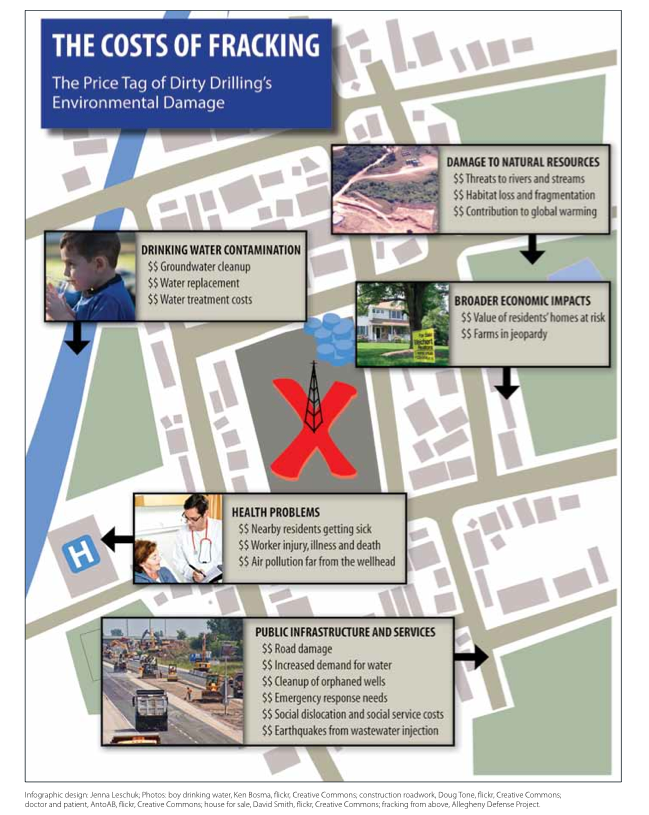ENVIRONMENT AMERICA
Introduction
America is in the midst of a fracking boom … and a fracking bust.
In North Dakota, times are booming. The state has rapidly become the nation’s second-largest oil producer due to the use of horizontal drilling and hydraulic fracturing (the combination of technologies used in fracking) to tap oil supplies from the Bakken Shale formation. North Dakota has seen its oil production triple over the span of just three years. Each month, about 200 new shale oil wells are drilled in the state, roughly four times as many as three years earlier. And with that intense drilling activity has come jobs; the state’s unemployment rate in October 2012 was a rock-bottom 3.1 percent.
North Dakota isn’t the only place experiencing a fracking boom. In the Niobrara Shale in Colorado and the Eagle Ford Shale in Texas, drillers can’t move quickly enough to tap oil-bearing shale formations, seeking to take advantage of persistently high world oil prices.
But other areas that have experienced similar “gold rush”-like conditions in recent years are now beginning to see the flip side of the fracking boom.
In western Colorado, drilling in the Piceance Basin has dropped dramatically, leaving towns and businesses that were thriving just a few years ago in difficult financial straits. Statewide, gas drilling activity dropped by nearly two-thirds between mid-2008 and mid-2012, even as oil drilling in another region of Colorado boomed.
In Texas’ Barnett Shale, drilling activity has fallen by three-quarters from its peak. Even in the Marcellus Shale basin of Pennsylvania, Ohio and West Virginia, visions of a massive and continuing economic boom have faded as drilling activity has waned. As of July 2012, the number of drilling rigs in Pennsylvania’s Marcellus Shale was 29 percent lower than the year before.
The leading culprit in the decline in natural gas drilling has been the dramatic fall in natural gas prices triggered by the boom in shale gas and other forms of unconventional gas.
The recent experience in these regions is a startling reminder that resource extraction booms are ephemeral by their very nature. But the impacts left by oil and gas drilling on landscapes, water resources, public health and public infrastructure are anything but temporary – they can last for years, even decades. Even today, America still bears the scars of coal mining and oil drilling activity that took place a century ago.
Cruel experience has shown that unless government requires fossil fuel companies to set aside money for environmental cleanup during the years when profits are being made, few resources will remain when the inevitable bust arrives – leaving polluted sites uncared- for and taxpayers to bear the costs of cleanup.
For areas experiencing widespread fracking, history shows that the time to ensure that adequate resources exist to repair the damage caused by drilling is now. Unfortunately, the oil and gas industry is exempt from many federal environmental laws that would require the industry to set aside resources for cleanup. Moreover, most state oil and gas laws are ill-equipped to protect the public from the impacts of conventional oil and gas drilling, much less the far greater impacts resulting from fracking.
This paper documents the many ways in which current state and federal laws leave taxpayers dangerously exposed due to inadequate requirements for financial assurance. It also proposes a framework for reform
of the nation’s financial assurance rules for oil and gas drilling, ensuring that they are robust enough to address the new challenges posed by fracking.
Read full report (PDF) here: Who Pays the Cost of Fracking?
About Environment America
www.environmentamericacenter.org
“Environment America Research & Policy Center is a 501(c)(3) organization. We are dedicated to protecting America’s air, water and open spaces. We investigate problems, craft solutions, educate the public and decision makers, and help Americans make their voices heard in local, state and national debates over the quality of our environment and our lives.”
Tags: Environment America, Fracking, Who Pays the Cost of Fracking







 RSS Feed
RSS Feed